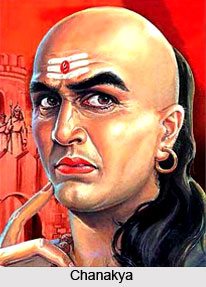 The art of drama was popular form of entertainment during the Maurya period. One gets to know about it from the Arthashastra of Chanakya and the inscriptions of Asoka. Particularly the Arthasastra furnishes a good deal of information on this subject. It throws light on the attitude of the State and people in general towards this art and those practiced it. The maintenance and working of the natakamandalis have also engaged the attention of Chanakya who laid the foundations of the Mauryan Empire, and his famous work, the Arthasastra, must have been written in the last quarter of the fourth century B.C. The Arthasastra is essentially a book on politics and administration; naturally in it we would not find an aesthetic appraisal of the silpas, fine arts or dramatic arts. Chanakya was very practical, sometimes even dry, while approaching them. He was unmoved by their aesthetic appeal but practical enough to exploit their utility. He had treated performing artistes as any other class of the king`s subjects and dispassionately discussed their duties and obligations towards the State as a class; he extends to them a few special privileges and limited state patronage.
The art of drama was popular form of entertainment during the Maurya period. One gets to know about it from the Arthashastra of Chanakya and the inscriptions of Asoka. Particularly the Arthasastra furnishes a good deal of information on this subject. It throws light on the attitude of the State and people in general towards this art and those practiced it. The maintenance and working of the natakamandalis have also engaged the attention of Chanakya who laid the foundations of the Mauryan Empire, and his famous work, the Arthasastra, must have been written in the last quarter of the fourth century B.C. The Arthasastra is essentially a book on politics and administration; naturally in it we would not find an aesthetic appraisal of the silpas, fine arts or dramatic arts. Chanakya was very practical, sometimes even dry, while approaching them. He was unmoved by their aesthetic appeal but practical enough to exploit their utility. He had treated performing artistes as any other class of the king`s subjects and dispassionately discussed their duties and obligations towards the State as a class; he extends to them a few special privileges and limited state patronage.
The natakamandalis or touring troupes, providing dancing, music, acrobatics, operas and dramatic performances were so popular that they were not allowed to enter villages as their performances would hinder agricultural activities by attracting agriculturists an thereby would harm the economic interests of the state and the cultivators. Chanakya further laid down that in the interest of production and all year round engagement of the agriculturist`s permanent recreation halls were not to be built in the villages. It appears that most of the performances were open-air shows or pavilions built temporarily. The villagers also organized shows or dramatic performances in the village by co-operative efforts and every body contributed towards its expense. However, women of the higher classes were perhaps not supposed to witness these stage performances along with men folk.
Chanakya also advised the king to organize samajotsva and participate in it according to the tradition of conquered people to appease their feelings, but forbids the use of weapons, fire or poison by the actors during their performances before the king for reasons of safety. Asoka prohibited samajas except some whom he considered to be innocent. He also provided in them feasts for eyes and soul by arranging for celestial sights like hasti, agnikandha, vimana, probably associated with religious processions like of which have always been vehicles of enjoyment and fun together with giving religious satisfaction.
According to Chanakya it was the duty of the king to provide teachers for women who acted on the stage to teach them such arts as singing, dancing, acting, writing, painting playing on instruments preparing garlands, ornamenting the body with different materials, and to spend on the above mentioned items from the treasury of the government (rajamandala). The sons of courtesans (ganikas) and the principal natas were appointed head teachers for all other stage players. He further mentions that the natas dancers, singers, instrumentalists, story-tellers, actors and aindrajalikas (jugglers) be employed as spies, who would try to reach the enemy king. Salaries for different categories of stage players were fixed. A kutilava was to be paid 350 panas yearly, while those who were conversant with playing on high class instruments were given 700 panas yearly. Besides there was courtesans and female slaves whose livelihood was acting on stage. It thus appeared as the dramatic performances, mimicry and satires, besides, singing, dancing and acrobatic feats were popular forms of entertainment during that period.




















